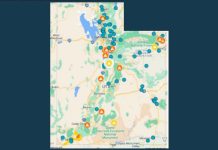SALT LAKE CITY, Utah, Aug. 29, 2017 (Gephardt Daily) — The public is being warned to stay out of two areas of Utah Lake due to the presence of E. coli at the Lindon Drain area, as well as Sandy Beach, officials warned Tuesday morning.
The majority of the lake continues to be under an advisory due to an algal bloom, according to a news release from the Utah Department of Environmental Quality.
The Utah County Health Department (UCHD) posted “caution” signs Tuesday morning at the two locations after elevated levels of E. coli were detected in water samples the Utah DEQ collected, the news release said. While the samples collected from the Lindon Marina tested under the limit for recreational water, the public is cautioned to stay out of the Lindon Drain area, which is frequented by those recreating near the Lindon Marina. The Lindon Drain area is located directly north of the Lindon Marina.
The UCHD posted caution signs at Sandy Beach in July when E.coli was first discovered. Those signs will remain in place, and say:
- Do not ingest lake water
- Water is unsafe for swimming and deep wading
- Wash hands after handling fish and lake water
- Wash hands/body after any contact with the lake water
“E. coli infection is a serious with severe complications in some cases,” UCHD executive director Ralph Clegg said in a prepared statement. “The public is strongly encouraged to take the caution seriously in these areas of high E. coli and stay out of the water to protect your health.”
E. coli is a bacterium that lives in the intestinal tracts of warm-blooded animals, including humans, indicating possible contamination of water of fecal waste. E. coli infection typically causes diarrhea and abdominal cramps, with or without a fever, and can lead to kidney failure and death.
DEQ’s Division of Water Quality has not been able to identify a clear source of E. coli for either site. The Lindon Drain area and Sandy Beach will continue to be sampled for E. coli contamination. For more information on E. coli water advisories, click here.
The advisory for the majority of Utah Lake remains in place due to sampling results remaining above the Environmental Protection Agency’s health-based threshold for recreational waters. Water quality crews continue to collect additional samples, with results available next week.
“Although blue-green algae are a natural part of many freshwater ecosystems, under the right conditions they can proliferate rapidly,” the news release said. “High levels of nutrients in the water, combined with warm temperatures, abundant sunlight, and calm water, can promote growth, resulting in extensive blooms. These blooms consist of cyanobacteria, often referred to as blue-green algae, a type of bacteria that poses risks to humans, wildlife, domestic animals and fish. Symptoms of exposure include headache, fever, diarrhea, abdominal pain, nausea and vomiting, and sometimes allergic-like reactions from skin contact.”
For concerns about possible human exposure, call the Utah Poison Control Center at 800-222-1222 or your physician.
DEQ will continue to provide updated information here.






